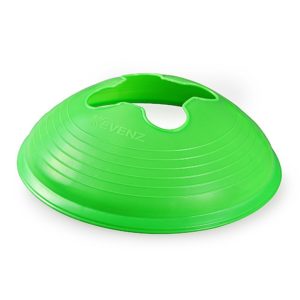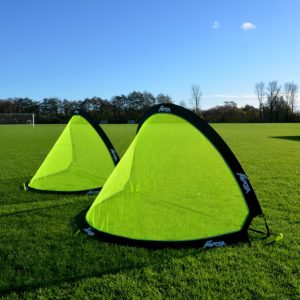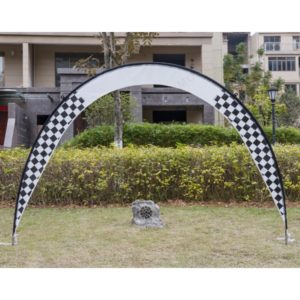There may come a point where you feel your flying has reached a plateau – you still enjoy flying, but you’re not able to push yourself quite as much.
Or maybe it’s because your only accessible flying field is rather boring. Mine is – it’s just a long, chewing gum shaped open field with trees and buildings on the sides(all pretty much inaccessible if I crash there), and a couple of pockets where I failsafe if I go too high.
Up until recently, I considered myself a freestyle only pilot – that was what I enjoyed doing, and there isn’t anyone here to race with. So I decided to invest in some cones and a couple of gates to set up some tracks to fly, and it’s the best decision I could have made. I only wish I did this a long time ago!
Even if you fly alone and aren’t planning on racing anytime soon, I would suggest you try flying tracks.
Here’s why.
Tracks are a measurable form of improvement
I feel that improvement in freestyle is hard to actively measure. Sure, you can see over time that your flying seems smoother, or you are hitting gaps with more finesse, or you’ve learned some new tricks, but the short-term progression may be hard to measure. It also may get boring very quickly, if you’re just powerlooping the same tree every time you go to fly.
With tracks, you can keep pushing yourself to fly faster and faster. You can measure the time it takes for you to fly a particular track, and the more you practice the track, the faster you’ll (hopefully) get. It’ll be a measurable improvement in your skill and performance.
It’s kind of like the time trial ghost in Mario Kart 64. You’re always competing against yourself, so there’s always incentive to improve and push yourself.
You can get creative with tracks, even in limited space
The beauty of a track is you don’t need much space to set up a decent track. In a comparatively small clearing, you can lay down a nice path, put some gates and flags, and you’re in business.
For example, all of the MultiGP Universal Time Trial tracks can be set up in an area of about 400 feet by 150 feet. If you corner very tightly, you can even get away with a smaller area.
Just pick up a piece of paper and start drawing tracks to your heart’s content – there’s no limit to the small variations you can introduce to make your tracks more challenging(or easier, too).
Do simple ovals, figure 8s, modified figure 8s, orbits, the possibilities are far and wide – and if you are adventurous enough, add some freestyle elements into your tracks. Commonly used are split-s maneuvers where you have to fly over a gate and come back through it.
If you’ve got some obstacles in your field, work them into the track. Go over, under, around, or between trees, for example.
Tracks pull you out of your comfort zone
One thing that I felt happened with me recently was that my flying became very “comfortable”. I would rarely do things that would really push the limits of my copters – partly for fear of crashing onto concrete and breaking something, or crashing in an inaccessible area and losing my copter.
So my routines were pretty standard faire – I’d do the same loops and tricks every single day, with only very slight variations – I’d flip over and under the same trees, dive the same posts, and fly similar lines.
Note: This is especially relevant if you have regular access to only one place to fly. If you happen to live in Atlanta, this may not apply to you.
Ever since I started to set up tracks, I’ve been pushing myself again – mainly to go faster – and as a result, my flying is slowly improving, too.
You’ll develop even greater control skills
Racing as fast as you can along a course, all the while making sharp turns, avoiding obstacles, and hitting gates, you’ll develop very fine control of your copter. You’ll learn to make tiny adjustments which let you hit gates, you’ll learn how to get your copter to go exactly where you want it to go, and you’ll learn how to not lose speed and altitude during any maneuver.
You’ll naturally become a better freestyle pilot
The skills you’ll develop and fine-tune by flying tracks will overflow into your freestyling, too. If you can hit a gate coming out of a turn and with respectable speed, why can’t you hit a gap you’re diving into from 100 feet above?
If you can get your quad to go exactly where you want it to go, why can’t you pull off sick freestyle moves?
Racing will help develop your reflexes, too. One thing I realized with my freestyling was that I’d stop for 1/2 a second to admire the move I just pulled off – that 1/2 second is critical to recovery and starting the next move!
When you’re racing, there’s no time to admire, only time to focus on the next gate! Hopefully racing will break that habit and when you freestyle again, it’ll show.
You’ll win some races
Hey, if you practice enough and end up at a race, you may even win a race or two(or more!).
What to get
For a budget track set up, at the very least, you’ll want some cones. Even if you don’t have anything else, cones are the bare minimum you need to set up a flight path to follow. You can just set cones however you like, and use natural obstacles as gates if available.

Pick some up from Amazon
For gates, you want to either get normal race gates from a multirotor vendor, or you can use pop-up goals if you can’t get your hand on gates.
The advantage of popup goals is they are super-fast to set up and put away. Gates are a little more cumbersome. Popup goals can just be opened and placed on the ground, whereas you’d have to drive in the gate spokes, open up the fiberglass pole, thread the fabric, and so on.
On the flip side, air gates are much more portable – popup goals only fold down once, so it’s a bigger thing to carry around, even though they come with a case.
The idea of using popup goals originally came up on Matthew Evans’ blog.
Note: This goes without saying, but you’ll have to cut out the netting if you use a popup goal!

Pop up goals(get 6 feet ones)

You can even put together some DIY gates using PVC piping.
Finally, you can pick up some flags if you wish. Personally, I’m not a big fan of flags if you’re flying alone, since flags are huge and very cumbersome to transport. You could get around using flags by just laying out your cones in a zig-zag or slalom path, and just imagine there are flags.
Get some flags from GetFPV
Conclusion
I am very happy that I started practicing tracks, and I suggest you at least try using cones and flying a track – if you think it’s something you’ll enjoy, then you can consider investing in some gates, too.
This makes total sense and I think its just what I need. I find myself worried too much about smoothness and tricks, but when it comes time to hit a gap at high speeds I feel like I have no control. Lining up a small gap while diving from 100 feet up is no easy task.
My only concern is camera angle. I don’t race but if I did, I would probably go a little higher camera angle which could throw off what I’m used to when i freestyle.
I stick to a 35-40 degree angle, which is more than enough for freestyle and should be fine for basic racing, too.